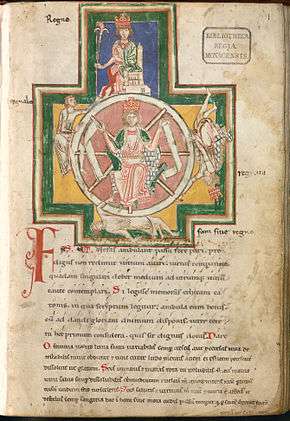Heinrich von Morungen
Heinrich von Morungen or Henry of Morungen (died c. 1220 or 1222) was a German Minnesinger.

Life
Almost nothing about his life can be deduced from Heinrich's songs. Possibly he is identical with the Hendricus de Morungen who is documented in Thuringia. This Hendricus belonged to the class of minor knights and presumably originated from the castle of Morungen near Sangerhausen. As a "retired knight" (miles emeritus) he received from his patron, Dietrich IV, Margrave of Meissen, a pension for his "high personal merits" (alta suae vitae merita). He transferred this in 1213 to the monastery of St Thomas in Leipzig, which he entered himself in 1217. According to 16th century sources, he died there in 1222 after a journey to India. In the Late Middle Ages, there was extant a "Ballad of the Noble Moringer", which transferred onto Heinrich von Morungen the stock theme of the return of a husband believed lost.
Works
There survive 35 Minnelieder by Heinrich, with 115 verses, of which only 104 are to be found in the great collection of the Codex Manesse. The melodies have not survived.
Heinrich is a very graphic lyricist: he particularly often makes use of images of shining (sun, moon, evening star, gold, jewels, mirror) as comparisons by which to describe the lady who is being sung and praised.
An essential theme in Heinrich's work is the demonic nature of Minne, the Middle High German word for this type of love, which for the mediaeval writers was embodied by the ancient classical goddess of love, Venus. Minne is experienced partly as a magical, pathological, even fatal power, but also as a religious and mystical experience.
In form and content the poems are influenced by the Provençal troubadour lyric: dactylic rhythms and through-rhymes (Durchreimung) occur frequently. Motifs in the content have also been taken over from the same source: for example, the motif, otherwise rare in German Minnesang, of the "notice of termination of the service of love" (Lied XXVII), the roots of which are to be found in classical literature (for example Ovid).
An introduction often attributed to Heinrich is the Wechsel or exchange (where the two parties speak alternately, but not directly to each other) in the Tagelied, although the device may be found in the poems of Dietmar von Aist, who is believed to be earlier.
Editions
- Des Minnesangs Frühling, Band 1: Texte, ed Hugo Moser und Helmut Tervooren, 38th revised edition, Stuttgart 1988 ISBN 3-7776-0448-8
- Heinrich von Morungen. Lieder, text, translation and commentary by Helmut Tervooren, (=Reclams Universal-Bibliothek; Nr. 9797), 3rd edition, Stuttgart 2003 ISBN 3-15-009797-5
References
- Helmut Tervooren: Heinrich von Morungen, in: Die deutsche Literatur des Mittelalters. Verfasserlexikon, ed Kurt Ruh et al., 2nd edition, vol 3, Berlin, New York 1981, col. 804–815 ISBN 3-11-008778-2
- Kesting, Peter (1969), "Heinrich von Morungen", Neue Deutsche Biographie (NDB) (in German), 8, Berlin: Duncker & Humblot, pp. 416–417; (full text online)
External links
- Heinrich von Morungen in the German National Library catalogue
- Works by or about Heinrich von Morungen at Internet Archive
- Works by Heinrich von Morungen at LibriVox (public domain audiobooks)

- http://texte.mediaevum.de/texte/morungen.htm - E-Texts of the songs at Mediaevum.de
- Digital Facsimile of Heinrich von Morungen's lyrics in the "Codex Manesse" (University Library, Heidelberg)
- "Nein, ja!" (Salzburger Ensemble for Ancient Music, Dulamans Vröudenton)
